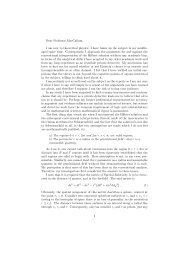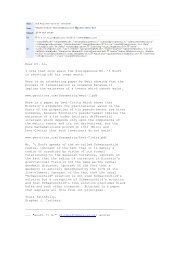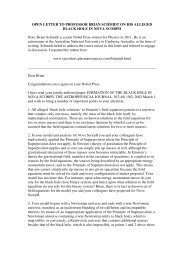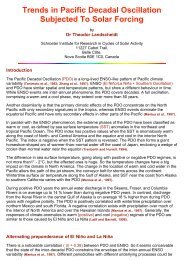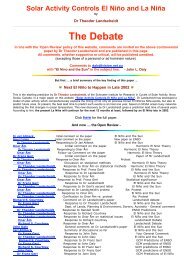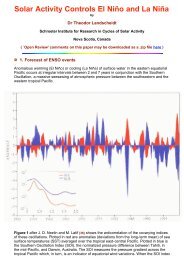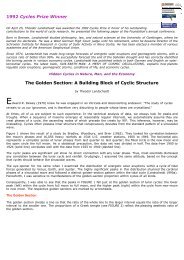Sun-Earth-Man - PlasmaResources
Sun-Earth-Man - PlasmaResources
Sun-Earth-Man - PlasmaResources
Create successful ePaper yourself
Turn your PDF publications into a flip-book with our unique Google optimized e-Paper software.
30 SUN-EARTtl-MAN: A MESH OF COSMIC OSCILLATIONS Ill. PREDICTIONSOFSOLAR ERUPTIONS 3 1<br />
111. PREDICTIONS OF SOLAR ERUPTIONS BASED ON PLANETARY<br />
CONSTELLATIONS<br />
The extensive example presented in the initial part of this monograph was<br />
intended to give a first survey of the advantages of a holistic approach and the<br />
new lund of multidisciplinary techniques that integrate basic a%ological views<br />
and modem scientific knowledge. In the following part, a body of evidence<br />
will be presented that supports the fundamental asho~ogical concept of the<br />
influence of planetary constellations on terrestrial phenomena. It is shown<br />
how planets modulate the <strong>Sun</strong>'s variable activity and thus indirectly influence<br />
diverse effects of solar-terrestrial interaction. These connections were tested<br />
by long-range predictions of solar activity and related terrestrial events<br />
checked by astronomical and geophysical institutes. John Addey's dictum<br />
"that astrological effects can be best understood in terms of cosmic periods<br />
and their harmonics", is substantiated by cyclic patterns formed by<br />
consecutive conjunctions of Jupiter with the centre of mass of the solar system.<br />
Such cycles and their harmonics emerge in time series of the <strong>Sun</strong>'s rotation,<br />
energetic solar eruptions, geomagnetic storms, and weather. The abundance<br />
of wild life and economic cycles have already been dealt with in the<br />
introductory part.<br />
The dependability of the forecasts in question, that were based on planetary<br />
configurations in the solar system, forms a sharp contrast to what scientists<br />
think of predictions based on planetary constellations. At the Fifth Astrological<br />
Research Conference, "Exploring Astrology", held in London on November<br />
22 - 23, 1986, the critic Geoffrey Dean was engaged in spreading "bad news<br />
for astrologers", as he put it. In his paper "Does Astrology Need To Be True?"<br />
he covered the same topic. He especially dealt with surveys of astrological<br />
predictions that proved spurious: "What most surely appears . . . is the<br />
perfect inanity of the astrofogical undertaking . . . what was announced did<br />
not happen, what happened was not announced." Geoffrey Dean, too,<br />
reviewed his own analysis of J. H. Nelson's daily foretasts of shortwave radio<br />
quality based on heliocentric planetary positions. With respect to his evidence<br />
that Nelson's relatively simple technique did not work he concluded: "Yet for<br />
30 years Nelson was convinced he saw a correlation that in fact did not exist.<br />
So we should not be surprised that astrologers, working with generally vaguer<br />
events and far more complicated techniques, can see correlations even if none<br />
actuaIly exist." Eventually, Geoffrey Dean stated: "The astrologers' response<br />
to these five surveys, which are the only ones I know of, has not been to<br />
generate surveys of their own. Instead there has been either silence or brusque<br />
dismissal. . . "<br />
This statement is not true, and Geoffrey Dean knew well that it was not in<br />
accordance with facts. He was present at the Second Astrological Research<br />
Conference, London, November 28129, 1981, when the positive yield of long<br />
range forecasts of energetic solar eruptions and their terrestrial effects was<br />
presented that was based on constellations of planets. These results were<br />
reviewed in a conference report in Correlntznn2" and thoroughly explained in<br />
papers published in proceedings of international science conferences and<br />
I F<br />
i p 13: Result of yearly fmecasts of energetk solar X-ray bursts equal to or greater than dm8 X2 (black l:n@es)<br />
andpmtonevmts(white himgles)for 1979 to 1981. Outof 29 event3 observed, 2781 theperiodaof pdicledachvity.<br />
scientific and astrological journals.17 Geoffrey Dean cannot argue that<br />
predictions of solar activity, even if based on planetary constellations, have<br />
nothing to do with astrology. He explicitly holds that the hypothesis of a<br />
planetary modulation of the <strong>Sun</strong>'s activity and an indirect influence on life on<br />
<strong>Earth</strong> would be entirely compatible with astrological tradition." This is why<br />
he thought it worthwhile to write a critical analysis of the forecasts of<br />
shortwave radio quality by John H. Nelson.lg<br />
Figure 13 shows the result presented at the Second Astrological Research<br />
Conference. The forecasts in question, covering the years 1979 to 1981, were<br />
published one year in advance respectively and checked by the astronomem<br />
W. Gleissberg, J. Pfleiderer and H. Wohl, as well as by the Space Environment<br />
Services Center, Boulder, U.S.A. " Each of the four frames presents the data<br />
for half a year. Elevated rectangles mark periods of predicted eruptional<br />
activity in a quantitatively defined range, whereas troughs indicate predicted<br />
lulls. Epochs of observed energetic eruptions of the defined classes are marked<br />
by triangles. Black triangles point to flares accompanied by X-ray bursts equal



